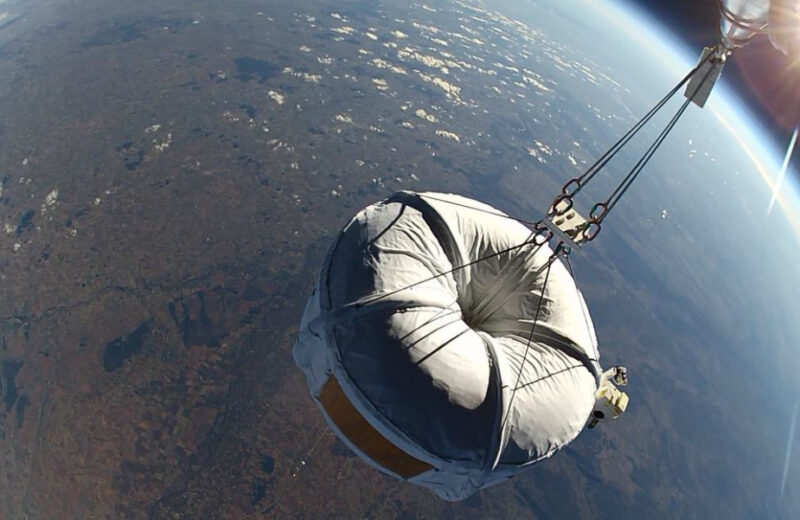Pre-rocket age space race inspires high-altitude balloon tourism

Spanish space tourism startup, Zero 2 Infinity has drawn inspiration from a US/Soviet space race that began in 1927 for its balloon technology.
Space tourism headlines are largely dominated by Branson, Bezos and Musk – all of which have invested in developing rockets, satellites and space planes. But one firm, founded by José Mariano López-Urdiales who published a paper on his concept back in 2002, is planning instead to use balloons to reach the edge of space – up to 25 miles (40km) above earth.
From the 1930s to the ‘60s, using high altitude balloons, the US and Soviet Union engaged in the first space race, a search for record balloon heights. Undertaken by the military, officers from both countries were the first men to reach the heights where the most impressive visual features that are associated with space travel were clearly visible, according to López-Urdiales. In 1927, Russian Prokofiev ascended to a height of 19km. In 1933, US officers Settle and Fordney reached a height of 18.7km. In 1956, US officer Kittinger ascended to 31.2km and jumped with a parachute.
Finally, a world record was set in 1961 when US airmen Ross and Prather reached 34.7km. That record stood until 2012 when Felix Baumgartner ascended to 38.9km in RedBull’s Stratos balloon. At a height of around 40km the sky is almost indistinguishable from the one seen in space, the curvature of the earth is clearly visible and the atmosphere seen as a delicate thin bluish layer, said López-Urdiales.
Founded in 2009, Zero 2 Infinity’s concept involves three technologies: its space travel service Bloon, high-altitude platform system Elevate and satellite launch system Bloostar.
Bloon is the flagship space travel offering, which will offer up to four passengers, alongside two pilots, a four-hour “day trip of a lifetime”. The helium-inflated balloon will ascend to altitude in around 1.5 hours, leaving two hours for viewing and an hour for descent, according to López-Urdiales. Passengers will be sealed inside a pressurised gondola with built-in redundancy systems such as a ballistic parachute in the event of any failure, CO2 scrubbing and cabin re-pressurisation. To descend, the pod will be fitted with parachutes, in particular, guided parafoils which provide steering and a softer landing via flare.
“The way this works is that once you need to come down, either nominally or off nominally, the gondola separates from the balloon and opens its own parafoil. The descent of the balloon is done separately. A balloon is almost like a parachute in itself. Both trajectories are predicted in real time and the decision to terminate the flight only takes place once you see that those trajectories are safe,” López-Urdiales tells Revolution.Aero.
But what happens if the balloon lands over sea or drifts into restricted airspace, such as an airport, on its descent? According to López-Urdiales, Zero 2 Infinity will know exactly where the balloon will be going days before the launch. “Only the ascent and descent matter for the airspace, which are relatively short phases of the flight. Most of the time we are literally above controlled airspace. The name of the game is prediction not control. Selecting carefully the launch base will guarantee that 99.99% of the time we can fly with no issues,” he said.
The firm is currently looking for Series A investment and has raised €6m ($x) to date. “I am seeking investment from any kind of investors that actually invest money. I do not have a preference. I have talked to hundreds of investors, from Boeing Horizon X, to Airbus Ventures and UHNWIs in between. In my experience the least likely ones to invest are the ones with higher chances of investing.” Said López-Urdiales.
The minimum amount required to perform a first human flight is €2.5m. To fully fund the commercial certification with EASA and FAA approvals for a fleet of pods to start flying tourists and vertically incorporate the production of our own balloons (which increases our margins), would require €50m.
“In any case we can provide a very oversized financial return. There can be an infinity of scenarios. Let’s take the $50m deal, which has the lowest risk and the lowest return. Assuming we give the investor 50% for that, in two years we can start flying tourists, after oneyear of tourism operation we could do an IPO, with sales at around €50m a year (and profit of €18m, if we did not have the factory it would be €12m) and growing 100% a year. The valuation we could expect for the company then could easily be €400m, possibly more because of all the IP about launching satellites from balloons etc.,” said López-Urdiales. “Check out the recent SPACs [special purpose acquisition company] of Worldview, or Virgin Galactic, which are both insane and testimony to the market wanting to invest in space but not finding good companies to invest in.”
Being based in Barcelona, Spain and not the US like many other companies in this sector, makes markets such as China available to Zero 2 Infinity. This is because US companies are barred from flying Chinese space tourists over fears of intellectual property theft.
After conducting research, López-Urdiales concluded that the total addressable market for space travel, in the region of €300,000 per seat, is at least €2bn per year. He argues that with Bloon, the market expands into luxury travel which experimental orbital flights do not. “The actual flight rate is not limited by demand, but how safely we believe we can grow the size of the operation.
“The market is embryonic as the demand is there but the offer is either unavailable (Virgin Galactic) or in the tens of millions of dollars a seat (SpaceX, Soyuz, etc.),” he added.






